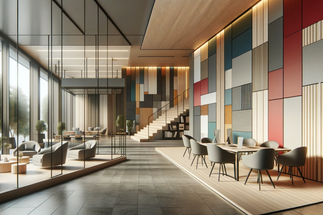A complete guide to Aluminum Composite Panels
In addition to their structural benefits, composite panels offer an eco-friendly alternative to traditional building materials, reducing the carbon footprint of construction projects. Their flexibility to various architectural styles makes them a popular choice among modern designers and architects. These panels are not just for new buildings. The buildings can also be made better by adding insulation and improving their appearance.
WHAT ARE COMPOSITE PANELS?
These panels are not only functional but also add an aesthetic dimension to buildings and structures. Architects particularly favor aluminum and stainless steel in projects where both appearance and structural integrity are of paramount importance. Different materials are assembled to create composite panels. Each material adds its own special qualities to make a better product that can do many things.
MATERIALS USED IN COMPOSITE PANELS
- Aluminum Composite Panels (ACPs): Apart from construction, ACPs are used to make modern vehicle bodies and aircraft because they are lightweight. Their reflective and weather-resistant properties make them ideal for both interior and exterior applications.
- Carbon Fiber Panels: These panels are strong and can withstand rust and temperature changes. Carbon fiber panels are a great choice for places that are rough on things. They are used more and more in high-performance applications because they are stronger and lighter than other materials.
- Other Composite Materials: Each material offers unique properties like thermal insulation or soundproofing, expanding the range of possible applications. These materials can include polymers, ceramics, and natural fibers, each selected based on specific project requirements.
COMPARING COMPOSITE PANEL MATERIALS
Materials that Last: Carbon fiber and other materials are strong and resistant to wear and tear, which means they can be used for a long time. This durability ensures that structures remain robust and maintenance-free for extended periods.
Weight and Flexibility: The flexibility of aluminum panels allows for creative architectural designs without compromising on structural integrity. Their lightweight nature also simplifies transportation and installation processes, reducing overall project costs.
Aesthetic Appeal: The variety in textures and finishes available in composite panels enables architects to achieve a wide range of visual effects. From matte finishes to glossy surfaces, these panels can mimic various natural textures, adding depth and character to any design.
APPLICATIONS OF COMPOSITE PANELS
Interior Applications: Their use extends to furniture design and modular systems, where their lightweight nature is highly beneficial. In interior design, these panels offer flexibility and ease of customization, making them a top choice for innovative and space-efficient solutions.
Exterior Applications: These panels also play a crucial role in energy-efficient building designs, contributing to better insulation and reduced energy costs. They are increasingly used in facade cladding, roofing, and other exterior applications due to their weather-resistant qualities and sleek appearance.
Specialized Uses: In sectors like marine and rail transport, these panels are used for their resilience and lightweight properties. Their impact resistance and ability to withstand harsh conditions make them ideal for these demanding applications.
INSTALLATION AND MAINTENANCE
The installation of composite panels often requires specialized tools and expertise, particularly for high-precision applications. It's important to engage experienced professionals to ensure proper installation and optimal performance of the panels.
Regular maintenance, although minimal, is crucial to retain the aesthetic and functional qualities of these panels. Simple cleaning and periodic inspections can significantly extend the life and appearance of composite panels.
ADVANTAGES AND DISADVANTAGES
One of the key advantages is the speed of installation, which can significantly reduce construction times. This efficiency is a major benefit in fast-paced construction environments where time is a critical factor.
However, the initial investment in composite panels can be higher than traditional materials, which might be a consideration for budget-sensitive projects. It's essential to evaluate the long-term benefits and cost savings that these panels offer over their lifespan.
CHOOSING THE RIGHT COMPOSITE PANEL FOR YOUR NEEDS
Understanding the fire resistance and insulation properties of different composite materials is also crucial in making an informed decision. This knowledge ensures safety and compliance with building regulations.
Additionally, considering the life cycle and recyclability of the panels can contribute to more sustainable construction practices. Selecting materials that align with environmental sustainability goals is increasingly important in modern construction.
CONCLUSION
As technology advances, the capabilities and applications of composite panels continue to expand, offering even more possibilities for innovative construction and design. The future of building and design is poised to be revolutionized by these versatile materials.
We hope this guide has provided valuable insights to help you make the best choice for your specific requirements. The correct selection of composite panels can significantly impact the success and sustainability of your project.
FAQ SECTION
What is a composite panel?
A composite panel is a multi-layered material made from two or more substances with differing properties, often used for its combined advantages of strength, durability, and aesthetic appeal. This unique combination results in a material that surpasses the performance of its individual components.
What are the disadvantages of composite panels?
They can be more expensive than traditional materials and may have environmental concerns depending on the materials used. Additionally, some types may require specialized installation techniques. It's important to weigh these factors against the benefits to determine the best choice for a specific project.
What is the difference between composite panels and sandwich panels?
While both are layered materials, sandwich panels typically have a different core material sandwiched between two outer layers. Composite panels, on the other hand, often focus on combining materials for specific structural or aesthetic properties. This distinction is critical in choosing the right panel type for specific applications.

